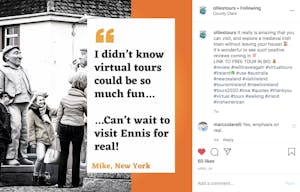- 50 minutes
- Digital Marketing
Sojern Presents: Data-Driven Strategies To Boost Your Marketing and Increase Ticket Sales
All Skill Levels
Get a behind-the-scenes-look into FareHarbor's 2024 season

The first half of 2020 has seen virtual experiences quickly emerge as a popular way for businesses to connect with their customers while their doors were closed and people were looking for ways to stay entertained at home. This innovative way to offer tours and activities can take quite a bit of planning, and after all the planning that goes into it, you want to make sure attendance is at its best. That is why it’s essential to create a marketing plan for your virtual events, just like you would for an in-person event, to make sure you’re reaching the people who would be interested in your offerings. This guide will offer some tips to market your virtual experience to help you have an engaging, well-attended online event.
If you haven’t created your online experience yet, you can start by checking out our guide to first steps to creating a virtual tour, exploring a variety of virtual platforms, and reading some steps to follow before going live. With many summer and fall holidays coming up, you might also consider whether your virtual experience aligns with a public holiday and plan your marketing strategy accordingly. Once you have a laid the groundwork for your virtual experience, follow the steps below to create a winning marketing plan!
It can be tempting to just hit “go live” on your virtual event without much planning, but if you want to reach your target audience and engage potential customers, it’s important to start with a marketing strategy as you would for any live event. The first step is to identify your goal for the virtual experience. For example, if you’re launching a subscription service that sends customers a box of items in the mail, you might set a sales goal around how many boxes you’d like to sell or how much money you hope to make. If your event is a live broadcast, your goal might be tied to the number of attendees or, if you’re collecting donations for a nonprofit during the broadcast, you might have a revenue number you want to hit.
Once you have a goal in mind, it’s time to identify your target audience. The great thing about virtual experiences is you can expand your reach far beyond what’s possible with an in-person event. Think bigger than just your local community — you might have past customers who live in a different state or country who would be interested in your event or people from all over the globe who are enthusiastic about what your company does. For a virtual experience, your target audience will be determined by interests rather than geography. Think of who the ideal person is who would be excited about your experience, then tailor your messaging to them and make sure you’re marketing on the platforms they are most likely to use.
 As you build your strategy, there are important questions to ask yourself to help you determine what your virtual experience will look like, how you will market it, and more. Here are some questions to get you started:
As you build your strategy, there are important questions to ask yourself to help you determine what your virtual experience will look like, how you will market it, and more. Here are some questions to get you started:
If your virtual experience will be broadcast live, you need to consider the timing of your event. Traditional timing for in-person events may not be ideal times for virtual events, so keep this in mind when finalizing the best days and times for your event. The perfect time will depend on a few factors, such as the timezone of the majority of your target audience, and their traffic patterns.
You can start by reviewing your Google Analytics data to see when your customers have been visiting your website or social media platforms in the past month or so. If your audience is global, try to choose a time that will be convenient for attendees from around the world. If you’re not sure what time would be best for your audience, you can use social media tools like polls on Instagram Stories to propose two times, allow people to vote, and select the most popular time.
Finally, consider whether your attendees need time to prepare for your experience. For example, if you’re hosting an online paint-along event, think about how much time your guests will need to buy or order the necessary supplies. You could post the supplies list two weeks out to give them plenty of time.
Now that you have your event goals and details nailed down, you can start planning how you’ll promote your virtual experience. The timing of your promotion will, of course, depend on the nature of your experience. According to Adobe, sign-ups for live virtual events spike around two to three weeks before the event, so this is the ideal time to push your social ads and email marketing. If your virtual experience is ongoing, such as weekly classes or subscriptions, the promotion will be ongoing. Either way, the tips below can help you get started, and you can tailor them to fit your needs.
Regardless of what type of virtual experience you’re promoting, a landing page is essential to make all the important information readily available in one place, plus it’s easy to share the URL across all your marketing platforms. Create a simple landing page that includes:
 Pro tip: Video is one of the best promotional tools for your event. According to Eventbrite, 52% of marketers believe that video is the content type with the highest ROI. You can share video across a variety of social channels, making it a useful and exciting tool to market your online experience.
Pro tip: Video is one of the best promotional tools for your event. According to Eventbrite, 52% of marketers believe that video is the content type with the highest ROI. You can share video across a variety of social channels, making it a useful and exciting tool to market your online experience.
Check out our Compass guides on utilizing video to promote your tours and activities, and get a breakdown of video platform pros and cons here.
This tip only applies if your virtual experience will be broadcast live. Gathering RSVPs online will help you get a better idea of how many people are planning to attend your event, and it also makes it easy to remind everyone that your event is coming up through reminder emails or push notifications. Depending on the platform you’re using to host your online event, you can gather RSVPs using a Facebook event page, Eventbrite, Zoom, or others.
 These platforms can also provide useful data about whether your promotion is reaching your target audience. If sign-ups are slow, consider using paid promotion to reach more users, sending out a marketing email, or employing other tactics. Another great benefit of platforms like Facebook is they send out notifications to users to remind them that the event is coming up or that the live broadcast has already started. That’s especially useful in times like these when we can easily lose track of time or forget to check our calendars.
These platforms can also provide useful data about whether your promotion is reaching your target audience. If sign-ups are slow, consider using paid promotion to reach more users, sending out a marketing email, or employing other tactics. Another great benefit of platforms like Facebook is they send out notifications to users to remind them that the event is coming up or that the live broadcast has already started. That’s especially useful in times like these when we can easily lose track of time or forget to check our calendars.
If you’re hosting a large online event or perhaps launching a brand-new subscription service or series of courses, a press release is an effective way to get the word out and reach a wider audience. Craft a press release that explains the value proposition of your online offering, the details of the event, information about the host and guests, and other compelling information about your online experience.
When selecting publications to send your press release to, start with your local newspapers and websites as well as any publications worldwide that are closely aligned with your offerings. For example, if you’re offering virtual coffee-making classes, a publication dedicated to coffee would be a perfect fit. Make sure to send your press release two to three weeks in advance to give the publications time to reach out to you or write up a piece about your virtual experience.
 There are so many ways to promote your virtual experiences on social media, and you have a lot of room to get creative and find what really resonates with your target audience. A great place to start is creating a variety of posts that you can use to promote your virtual experience, such as a series of short video clips that offer a sneak peek, engaging images, and more. Create all your promotional materials upfront along with a posting calendar to plan out all your posts in advance. You can choose to stick with organic posts if you already have a large social media following or allocate a little bit of money for paid posts to reach a wider audience.
There are so many ways to promote your virtual experiences on social media, and you have a lot of room to get creative and find what really resonates with your target audience. A great place to start is creating a variety of posts that you can use to promote your virtual experience, such as a series of short video clips that offer a sneak peek, engaging images, and more. Create all your promotional materials upfront along with a posting calendar to plan out all your posts in advance. You can choose to stick with organic posts if you already have a large social media following or allocate a little bit of money for paid posts to reach a wider audience.
It’s always a good idea to create a hashtag for your event. It can help you gain some traction by giving people an easy way to show their support for your company and encouraging user-generated content. Take advantage of features like Instagram Stories to create fun and engaging posts that will get people excited. For example, you can use polls to get input from your followers, create a countdown to the day of your event, ask people to send in questions they’d like to see answered during your event, and so much more. Check out our Instagram Stories guide for ideas, and check out what other companies are doing on social media to spark some creativity. You can also explore our guide with tips to make your content go viral.
While virtual experiences are a great way to reach brand-new audiences, you already have a great audience to get started with — your existing customers in your email list! You already know the people in your email list are interested in what your company has to offer, so make sure you send out a marketing email inviting them to your event. In addition to a dedicated email, make sure to include your event in your newsletter if you have one, giving your event as much exposure as possible.
If you have any sponsors for your event or special guests, be sure to ask them to promote the event on their own social media channels or emails to further expand your reach. Make this easy for them by providing all the promotional materials, including copy, images, and links. Another way to cross-promote is to do a guest post on your guests’ blog.
Your website is a prime spot to promote your virtual experience. Homepages look a little different than usual right now with all the COVID-19 updates and notices, but you also want to offer your customers the type of experience they came to your website for. Make sure your event is prominently displayed on your home page, and include a link to the landing page with all the event information to capture those users that find your website through search engines and other sources. Check out our guide on how to create a highly converting home page!
 Encourage Attendees to Share
Encourage Attendees to ShareOnce someone has signed up to attend your event, make it easy for them to share with their friends by providing social media share buttons, text that they can copy and paste, or image templates they can customize. If people are using your social media hashtags, repost their photos to encourage others to do the same so they can be featured on your platforms!
Virtual experiences allow plenty of opportunities for your audience to engage. Take advantage of this to make your guests feel like a part of the experience. If you’re broadcasting live on Facebook or YouTube, for example, you can ask people to send in questions through the comments. On platforms like Zoom, you can use the Q&A feature to invite audience questions. A lot of companies are using virtual experiences to raise funds for a good cause. Typically, when people donate they can send a personalized message to be read out by the host. Audience participation makes for a lively event, and this can encourage more people to come back for your next online experience!
If it makes sense for your event, you could share the broadcast in full after it airs live so people who missed it can enjoy it on-demand. If your event was free to attend and there are no conflicts with sharing it afterward, it can be a great way to get additional views and extend the life of your online event. If you want to keep the experience exclusive for those who attended (for example, if you charged an admission fee), you could share only a snippet of the experience to promote future virtual events.
There are many FareHarbor clients who are offering exciting and creative virtual experiences. Check out a few of them for some inspiration!
 Casanova Tours’ Virtual Cooking Classes
Casanova Tours’ Virtual Cooking Classes The Casanova Tour team adapted their tour offerings for a global audience with an immersive experience that allows customers to enjoy Venice’s beautiful culture and cuisine at home. They offer live cooking classes that provide customers with the proper ingredients and then connect them with local chefs to make some of Italy’s most renowned dishes.
 Lyon Wine Tastings’ Virtual BYOB Tasting
Lyon Wine Tastings’ Virtual BYOB TastingCaroline Conner of Lyon Wine Tastings transformed her intimate, local wine tastings into online experiences. By offering free, virtual BYOB wine tastings, Conner can continue to share her passion and knowledge of wine by educating participants on wine tasting techniques, while also creating a platform that fosters interaction and engagement at a time when it’s needed the most.
 Unexpected Atlanta’s Food Tour in a Box
Unexpected Atlanta’s Food Tour in a BoxUnexpected Atlanta wants customers to continue to enjoy the best of their city, even if they can’t visit the restaurants in person. Their ATL Food Tour Box allows customers to bring the fun to their homes with delicious food for six people, history, and chef interviews, plus ingredients and techniques for an interactive recipe demo, and a bonus of $160 worth of gift certificates to Atlanta’s top-rated tours.
 Starboard’s 360° Amsterdam Canal Cruise
Starboard’s 360° Amsterdam Canal CruiseFor those wishing they could be gliding along the canals of Amsterdam right now, Starboard’s Virtual Canal Cruise is a great (and free!) option. Customers can enjoy their fun and informative virtual cruise from their couch, using the information buttons around the boat to get some cool stories and recommendations.
 Dolphin Quest’s Daily Live Stream
Dolphin Quest’s Daily Live StreamFun for families and animal lovers, Dolphin Quest has been going live on Facebook every morning to showcase the daily routines of dolphins and trainers and show off their amazing skills. It’s an engaging way to learn more about dolphins and get customers excited about visiting them in the future.
 Akumal Monkey Sanctuary’s Virtual Tour
Akumal Monkey Sanctuary’s Virtual TourSeeing monkeys up close is a unique experience, but meeting them online is a fun alternative for families looking for ways to stay entertained at home. Akumal Monkey Sanctuary’s virtual tour includes an introduction to the sanctuary and its residents and a chance to ask questions and learn more about the monkeys.
You’ve put a lot of work into creating your virtual experience, and with these marketing tips, you can set yourself up for success by reaching a wider audience. While many virtual experiences have been inspired by challenging times, it’s also a time for innovation and creativity. You might just find that connecting with your customers online will be a great addition to your business for years to come. For more on how to make the most of online spaces, check out our virtual experiences guides.